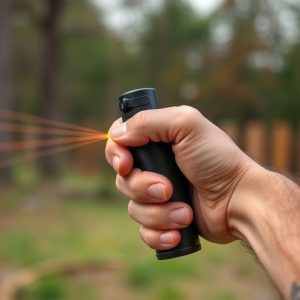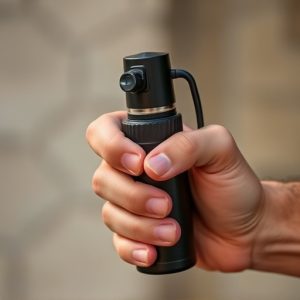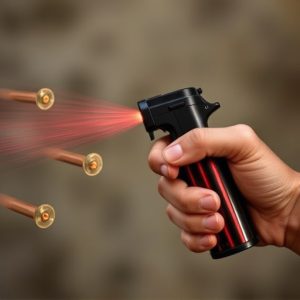Tactical Pepper Spray: Composition, Choice, and Post-Exposure Care
Tactical pepper spray, potent with capsaicin, offers powerful self-defense by neutralizing attackers…….
Tactical pepper spray, potent with capsaicin, offers powerful self-defense by neutralizing attackers through eye and respiratory irritation. Effective use requires training, while immediate care post-exposure is crucial. Selecting the right spray involves understanding specific needs, active ingredients, range, application ease, and weather resistance. In case of exposure, relocate to a safe area, remove contaminated clothing, flush eyes with water for 15 minutes, provide fresh air if needed, apply cold compresses, and seek medical attention for severe or persistent symptoms, especially for individuals with pre-existing respiratory conditions – Immediate Care for Pepper Spray is paramount.
Tactical pepper spray is a powerful tool for self-defense, offering a non-lethal yet effective means of deterring potential threats. In this comprehensive guide, we’ll explore the science behind tactical pepper spray, its composition, and why it’s an essential addition to any personal safety arsenal. We’ll also navigate the market to help you choose the right spray for your specific needs. Furthermore, we’ll delve into immediate care after pepper spray exposure, providing insights on symptoms and treatment options.
- Understanding Tactical Pepper Spray: Its Composition and Effectiveness
- Choosing the Right Pepper Spray for Your Self-Defense Needs
- Immediate Care After a Pepper Spray Exposure: Symptoms and Treatment
Understanding Tactical Pepper Spray: Its Composition and Effectiveness
Tactical pepper spray is a powerful self-defense tool designed for immediate impact and maximum effectiveness. Its composition includes capsaicin, the same compound that makes chili peppers spicy, combined with other agents to enhance its potency and duration. This potent mix creates a burning sensation in the eyes and respiratory system, temporarily disabling an attacker, allowing users to escape or gain precious time to call for help.
The effectiveness of tactical pepper spray lies in its ability to neutralize threats quickly. A well-placed burst can disrupt an assailant’s balance and visibility, giving the user a crucial head start. Immediate care after exposure is essential; victims should wash their faces and eyes with water, seek fresh air, and consider seeking medical attention if symptoms persist or severe reactions occur. Proper training in its use ensures users understand the spray’s range, wind conditions, and safety measures to maximize its effectiveness as a last line of defense.
Choosing the Right Pepper Spray for Your Self-Defense Needs
Choosing the right pepper spray is a crucial step in equipping yourself for self-defense. The first consideration is understanding your specific needs. Whether you’re looking to deter an attacker in close quarters or create distance during an assault, different sprays cater to distinct scenarios. Active ingredients and concentration play a significant role; higher concentrations offer more protection but also require proper training to use effectively.
Additionally, features like range, ease of application, and weather resistance should be taken into account for immediate care. Some sprays are designed for quick deployment in close proximity, while others provide a longer reach, allowing you to maintain distance. Always opt for reputable brands that offer clear instructions and ensure you understand local regulations regarding self-defense tools like pepper spray.
Immediate Care After a Pepper Spray Exposure: Symptoms and Treatment
In the event of a pepper spray exposure, immediate care is crucial for mitigating the effects and ensuring swift recovery. If someone comes into contact with pepper spray, it’s important to act quickly. The first step is to move the affected individual to a safe, well-ventilated area away from the source of the spray. Remove any contaminated clothing or accessories, paying special attention to the eyes, nose, and mouth as these are common points of entry for the irritants in pepper spray.
Symptoms can vary but often include tearing, itching, burning sensations, runny nose, coughing, difficulty breathing, and red or water-filled eyes. To alleviate these symptoms, flush the eyes gently with clean water for at least 15 minutes. If breathing is affected, provide the person with fresh air and encourage them to sit up straight. Applying a cold compress to the face may help reduce swelling and pain. Medical attention should be sought if symptoms persist or worsen, as pepper spray can have severe health implications, especially in individuals with pre-existing respiratory conditions.
Tactical pepper spray can be an effective tool for self-defense, but it’s crucial to understand its composition, effectiveness, and proper usage. By choosing the right spray for your needs and knowing how to administer it, you can ensure better protection in potentially dangerous situations. Additionally, being prepared with knowledge about immediate care after exposure is essential. Following the right treatment procedures can help alleviate symptoms and ensure faster recovery. Remember, understanding and practicing these steps can make a significant difference when facing a pepper spray encounter.


